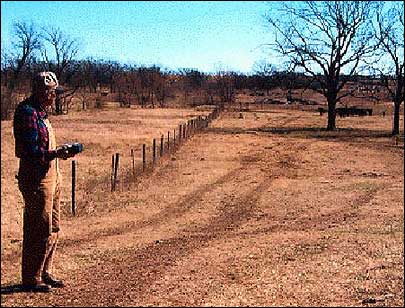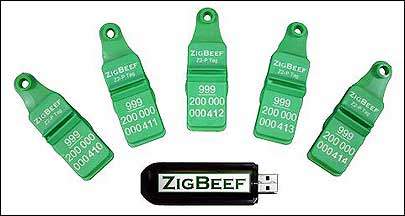Feb 21, 2008A new active RFID system is set to help ranchers and rodeos track animals from a distance, as well as measure an animal's movement during a rodeo competition, for instance, when it is difficult to track exactly when a bull came out of its gate, or when it was roped and immobilized. The solution, provided by a startup company called ZigBeef, is being developed to allow cattle ranchers and their financial backers to track each head of cattle on a daily basis. The system became commercially available two weeks ago.
By using a system based on the ZigBee (802.15.4) standard, users can capture an animal's unique ID number with a handheld interrogator from several hundred feet away. In this manner, says John Hassell, ZigBeef's president and CEO, ranchers can keep a much more accurate count of their animals, since the active system makes reading easy enough for ranchers to do so daily. The system is being offered as an alternative to the passive RFID tags approved by the U.S. Department of Agriculture (USDA) for the National Animal Identification System (NAIS).
Most interest thus far, Hassell says, has come from "serious commercial producers" in the United States, United Kingdom and South America, as well as from cattle lending associations such as banks or credit corporations. With cattle valued at an average of $1,000 per head, he adds, there is an interest in tracking that asset and ensuring it does not leave the ranch, stays healthy and is not stolen.
Ranchers typically use the system by capturing cattle ID on a daily basis while they are being fed. Unlike with passive systems, users need not approach an animal to capture its tag number. Rather, a farmer simply uses a laptop with a USB RFID reader—designed and built by ZigBeef—when feeding the animals.
Alternatively, Hassell says, ZigBeef has also designed an interrogator with a PDA interface that can be used with a Hewlett Packard iPAQ or other PDA with a serial connection. Cattle usually cluster around the feeding truck, and all ID numbers can be captured on the USB reader at that time. Upon returning to the office, the user can plug the USB stick directly into a computer, where the data is then downloaded as a list of serial numbers.
By next year, Hassell says, the company plans to offer the system with ZigBee mesh capabilities so cattle tags can transmit data from one to another, thereby extending the read range depending on how many cattle are spread throughout the area, with one tag sending data to the next, and ultimately to a reader. In the meantime, he notes, further research and development must first be conducted. "There are a lot of unique challenges with cattle," Hassell says. "Normally a hop-to-hop environment is stationary," whereas cattle are constantly moving.
The ZigBeef tags also come with motion sensors that, when the animals move, cause the tags to transmit their signals every few seconds, so that users can track the animals' movements. This can be especially useful in rodeos, Hassell says, since the system can track how quickly an animal is out of a pen, how many times it turns and the amount of movement at any given time. In the case of team-roping of cattle, for instance, a tag attached to the animal's ear tracks and sends data regarding how much the animal moved, and for how long, before it was roped by rodeo performers. According to Hassell, the tag itself holds a battery but is not much thicker than a credit card.
Gary Poythress, president of Rodeo Computer Services Inc., based in Stevenville, Texas, is testing the ZigBeef system and hopes to provide it to his rodeo and cattle ranch customers to use in conjunction with his company's animal management software package. The system would then enable rodeo managers to monitor their animals using ZigBeef hardware on the Rodeo Computer Services software platform. "We're working with ZigBeef to design a more-efficient tracking system," Poythress says.
Poythress is a member of the United States Team Roping Championships (USTRC). The association, he explains, is part of a drive to "make raising livestock more profitable. We [USTRC members] are finding monitoring cattle with active RFID allows us better monitoring with less equipment." Poythress says the first hardware test took place last week, in which USTRC cattle ran past the reader at a distance of about 100 feet, "and it went extremely well. We got information we needed on the first pass," he says. "I'm very optimistic about it."
Bulls may be the next opportunity for the ZigBeef system. In the case of bull riding, the animal would wear a ZigBeef tag with a motion sensor, which would transmit data to a mobile reader so the rodeo audience would have data regarding how much the bull was actually bucking the rider before throwing him. Hassell envisions the establishment of a bull-riding severity index rating that would give audience members a better idea of a particular bull ride's difficulty.
Because the USB stick is fairly inexpensive, Hassell says, the price of the system is competitive with that of a passive system, depending on how many tags a rancher has to purchase. He declines to specify a price for the tag or interrogator. In addition, he says, the system is also being considered for the tracking of domesticated deer, as well as for asset tracking at oil drilling sites.



